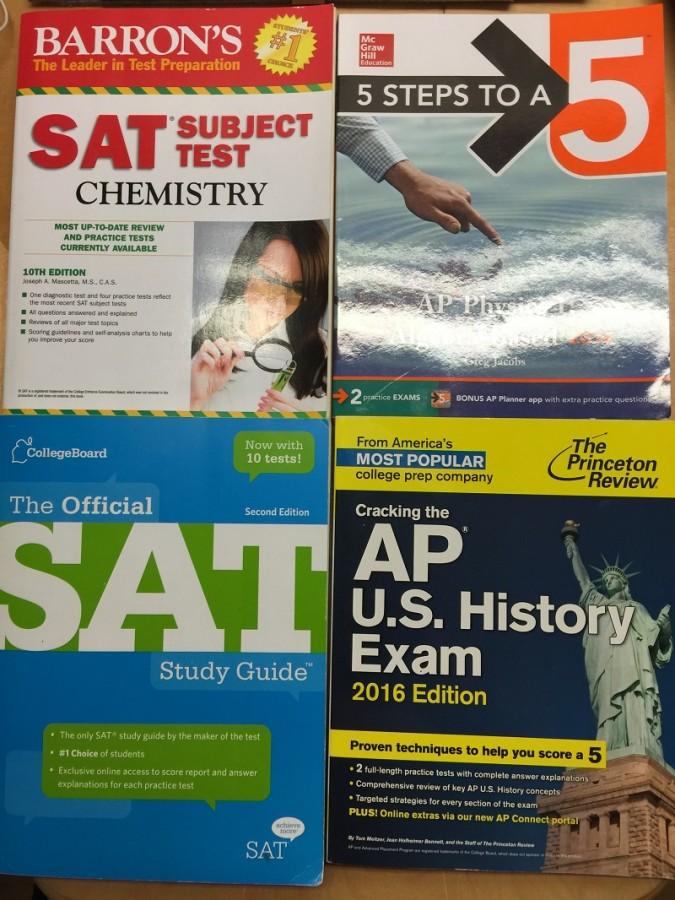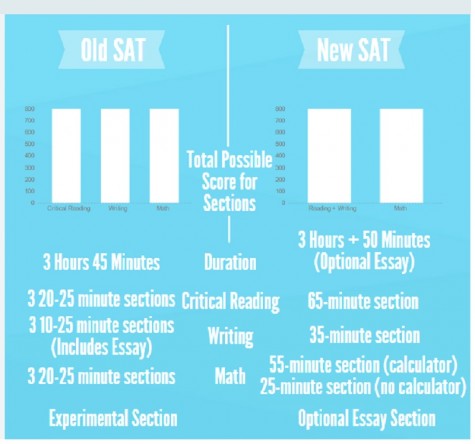Hotly-debated new SAT format removes formulas and ambiguity
While trying to study for the newest version of the SAT, I discovered many key similarities between the test and other standardized tests. By reducing subjectivity from the grading process while still requiring students to analyze broadly, standardized tests remain an effective way of assessing students.
March 10, 2016
As I prepared for the remodeled SAT during the summer, I worked through over 20 sets of old practice problems, each with an essay and all three types of multiple choice sections. While many students and teachers thought the previous SAT felt too formulaic and narrow, I found that the problems in my practice tests allowed test-takers to consider different viewpoints, especially in the critical reading passages.
The new SAT format is a mystery for students, since past exam material is nonexistent. For some, the new format evens out the playing field for all test-takers by discouraging rote memorization. For others, the new format restricts the test-taker by reducing the open-endedness of each test question, especially in the “optional” essay section.
After preparing for both versions, I found that each type of test had merit.
In the previous version of the SAT, the multiple choice sections required a test taker to consider multiple viewpoints to answer all of the questions. Similarly, the essay portion encouraged broad thinking by asking open-ended questions.
The new SAT test narrows the scope of the topics and ideas explored by the student. For example, it limits the essay to document-based analysis — the provided documents guide the student’s writing. While the new essay encourages more narrow-minded thought, the multiple choice still involves analyzing multiple viewpoints.
These changes attempt to remove the ambiguity in grading each assessment. Rather than memorizing examples before entering the exam room, students are forced to think on the fly, adjusting to the documents they see on the test. SAT graders may also find it easier to judge a student’s focus and attention to detail by having the document selection — a kind of roadmap — right in front of them.
In other standardized tests, such as Advanced Placement (AP) exams, the subjects tested typically involve more factual knowledge and comprehension of the way things work. For instance, AP history tests contain essay portions that allow students to craft their own arguments based on the facts they learned in class.
Unlike either form of the SAT, these tests lack room for interpretation because every question has a single indisputable, correct answer. Such tests are forced to be straight-forward to make grading as consistent as possible.
Whereas students are not expected to take courses in preparation of the SAT, AP exams stem from AP coursework, making this less interpretive approach seem logical. And while the Fall 2002 edition of the Journal of Human Resources contained a paper that expressed that standardized testing is not objective, but rather based on subjective decisions made by the proctors of the tests, a June 2006 Public Agenda survey of public middle and high school students found that 79% of students think standardized testing is fair.
Although the new SAT format limits the number of ways a student can tackle a prompt, it still acknowledges the importance of considering various viewpoints. After considering the differences between forms of standardized testing, I realized that the SAT’s approaches seem consistent across the board.
Ultimately I’ve found that, rather than promoting narrow-minded thinking, standardized tests are purposely fair and objective. They allow students to interpret the prompt and respond accordingly.



















![“[Building nerf blasters] became this outlet of creativity for me that hasn't been matched by anything else. The process [of] making a build complete to your desire is such a painstakingly difficult process, but I've had to learn from [the skills needed from] soldering to proper painting. There's so many different options for everything, if you think about it, it exists. The best part is [that] if it doesn't exist, you can build it yourself," Ishaan Parate said.](https://harkeraquila.com/wp-content/uploads/2022/08/DSC_8149-900x604.jpg)




![“When I came into high school, I was ready to be a follower. But DECA was a game changer for me. It helped me overcome my fear of public speaking, and it's played such a major role in who I've become today. To be able to successfully lead a chapter of 150 students, an officer team and be one of the upperclassmen I once really admired is something I'm [really] proud of,” Anvitha Tummala ('21) said.](https://harkeraquila.com/wp-content/uploads/2021/07/Screen-Shot-2021-07-25-at-9.50.05-AM-900x594.png)







![“I think getting up in the morning and having a sense of purpose [is exciting]. I think without a certain amount of drive, life is kind of obsolete and mundane, and I think having that every single day is what makes each day unique and kind of makes life exciting,” Neymika Jain (12) said.](https://harkeraquila.com/wp-content/uploads/2017/06/Screen-Shot-2017-06-03-at-4.54.16-PM.png)








![“My slogan is ‘slow feet, don’t eat, and I’m hungry.’ You need to run fast to get where you are–you aren't going to get those championships if you aren't fast,” Angel Cervantes (12) said. “I want to do well in school on my tests and in track and win championships for my team. I live by that, [and] I can do that anywhere: in the classroom or on the field.”](https://harkeraquila.com/wp-content/uploads/2018/06/DSC5146-900x601.jpg)
![“[Volleyball has] taught me how to fall correctly, and another thing it taught is that you don’t have to be the best at something to be good at it. If you just hit the ball in a smart way, then it still scores points and you’re good at it. You could be a background player and still make a much bigger impact on the team than you would think,” Anya Gert (’20) said.](https://harkeraquila.com/wp-content/uploads/2020/06/AnnaGert_JinTuan_HoHPhotoEdited-600x900.jpeg)

![“I'm not nearly there yet, but [my confidence has] definitely been getting better since I was pretty shy and timid coming into Harker my freshman year. I know that there's a lot of people that are really confident in what they do, and I really admire them. Everyone's so driven and that has really pushed me to kind of try to find my own place in high school and be more confident,” Alyssa Huang (’20) said.](https://harkeraquila.com/wp-content/uploads/2020/06/AlyssaHuang_EmilyChen_HoHPhoto-900x749.jpeg)







